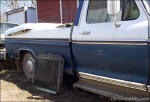|
Sunday, March 22, 2004 - I made another run today to
the salvage yard I was at last weekend. Before I left last time, the
owner said he had what he thought was a 390 that was in a '74 F-100, and
it was a running vehicle. I did a quick check of the stroke to
verify that it was a 390 and not a 360, and when it was indeed
determined to be a 390, I told him I wanted it. He agreed on a price of
$75.00.
I got
started disconnecting the engine about 10:30 AM and had it ready to pull
by about noon. I was amazed at how easily everything came apart...even
the exhaust pipe connection at the manifolds just unbolted without
breaking any studs! We latched onto the engine with his front-end loader
and yanked it out...after a quick pause to disconnect the shifter
linkage which I'd forgotten to do. (I always forget one thing when I do
this...and it varies each time!)
When he
asked me if I wanted him to set it down so I could disconnect the
tranny, I made the decision right then to just take home the C-6 as
well. Not only was it easier at the time, but it turns out the tranny
had a slip yoke in the transmission tailshaft, unlike most longbed
trucks which had a bolt-on yoke and a two-piece driveshaft with a
built-in slip coupler. This '74 still had the two-piece driveshaft like
normal, but had a car-type transmission with a shorter slip yoke. I was
able to grab a regular car-type slip yoke (which is about 3-4 inches
longer) to use for my project. |

Fig. 1 - Here's the '74 F-100 about to undergo an
engine-ectomy. Notice anything strange about this truck? Look closely!

Fig. 2
- If you were able to pick out the '72 box on this '74, you've got
good eyes. A previous owner minimized the obvious differences by
slapping on some universal trim molding. You might not even notice it at
a quick glance. A hole was cut into the bed behind the left rear tire
to accommodate the fuel tank filler. |